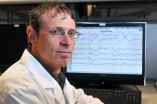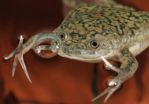(Press-News.org) A team of paleontologists and geologists from Argentina and the United States on Jan. 13 announced the discovery of a lanky dinosaur that roamed South America in search of prey as the age of dinosaurs began, approximately 230 million years ago.
Sporting a long neck and tail and weighing only 10 to 15 pounds, the new dinosaur has been named Eodromaeus, the "dawn runner."
"It really is the earliest look we have at the long line of meat eaters that would ultimately culminate in Tyrannosaurus rex near the end of the dinosaur era," said Paul Sereno, University of Chicago paleontologist and National Geographic Explorer-in-Residence. "Who could foretell what evolution had in store for the descendants of this pint-sized, fleet-footed predator?"
Sereno and his colleagues describe a near-complete skeleton of the new species, based on the rare discovery of two individuals found side-by-side, in the Jan. 14, 2011 issue of the journal Science. The paper presents a new snapshot of the dawn of the dinosaur era—a key period that has garnered less attention than the dinosaurs' demise. "It's more complex than some had supposed," Sereno said.
Set in picturesque foothills of the Andes, the site of discovery is known as the "Valley of the Moon," said the report's lead author, Ricardo Martinez of Argentina's National University of San Juan. For dinosaur paleontologists, it is like no other.
"Two generations of field work have generated the single best view we have of the birth of the dinosaurs," Martinez said. "With a hike across the valley, you literally walk over the graveyard of the earliest dinosaurs to a time when they ultimately dominate."
The area was once a rift valley in the southwest corner of the supercontinent Pangaea. Sediments covered skeletons over a period of five million years, eventually accumulating a thickness of more than 2,000 feet (700 meters).
Volcanoes associated with the nascent Andes Mountains occasionally spewed volcanic ash into the valley, allowing the team to use radioactive elements in the ash layers to determine the age of the sediments.
"Radioisotopes—our clocks in the rocks—not only placed the new species in time, about 230 million years ago, but also gave us perspective on the development of this key valley," said Paul Renne, director of the Berkeley Geochronology Center in California. "About five million years of time are represented in these layers, from one end to the other."
In the oldest rocks Eodromaeus lived alongside Eoraptor, a similar-sized, plant-eating dinosaur that Sereno and colleagues discovered in the valley in 1991. Eoraptor's descendants would eventually include the giant, long-necked sauropods. Eodromaeus, with stabbing canine teeth and sharp-clawed grasping hands, is the pint-sized precursor to later meat-eaters called theropods, and eventually to birds.
"We're looking at a snapshot of early dinosaur life. Their storied evolutionary careers are just unfolding, but at this point they're actually quite similar," Sereno said.
Eodromaeus at the root of the dinosaur family tree
Vexing scientific questions at the dawn of the dinosaur era include what gave them an edge over competitors, and how quickly did they rise to dominance? In Eodromaeus' day, other kinds of reptiles outnumbered dinosaurs, such as squat lizard-like rhynchosaurs and mammal-like reptiles. The authors logged thousands of fossils unearthed in the valley to find, as Martinez remarked, that "dinosaurs took their sweet time to dominate the scene."
Their competitors dropped out sequentially over several million years, not at a single horizon in the valley.
In the red cliffs on the far side of the valley, larger plant- and meat-eating dinosaurs had evolved many times the size of Eoraptor and Eodromaeus, but it would be even later when they dominated all land habitats in the succeeding Jurassic and Cretaceous periods.
"The story from this valley suggests that there was no single advantage or lucky break for dinosaurs but rather a long period of evolutionary experimentation in the shadow of other groups," Sereno said. Other researchers on the paper tracked climate change and other conditions across the layers of the valley. "The dawn of the age of dinosaurs," Martinez remarked, "is coming into focus."
INFORMATION:
Citation: Ricardo N. Martinez, Paul C. Sereno, Oscar A. Alcober, Carina E. Colombi, Paul R. Renne, Isabel P. Montañez, Brian S. Currie, "A Basal Dinosaur from the Dawn of the Dinosaur Era in Southwestern Pangaea," early online edition of Science, Jan. 14, 2011.
Funding sources: The Whitten-Newman Foundation, Island Fund of the New York Community Trust, Earthwatch Institute, Consejo Nacional de Investigaciones Científicas y Técnicas, Packard Foundation, Gorden Getty Foundation, National Science Foundation, and the National Geographic Society.
Irvine, Calif. — The reward systems at universities heavily favor science, math and engineering research at the expense of teaching, which can and must change. That's the conclusion of UC Irvine biology professor Diane K. O'Dowd and research professors at Harvard University, Yale University, the Massachusetts Institute of Technology, and elsewhere.
Writing in the Jan. 14 issue of Science magazine, the authors note that professors have two responsibilities: to generate new knowledge and to educate students. But, they maintain, "although education and lifelong learning ...
Researchers from Cardiff University are opening up a new way of using hydrocarbon feedstocks to make a range of valuable products.
Hydrocarbons are an extremely important energy resource but, although widely available from fossil fuels, are extremely difficult to activate and require very high temperatures in current industrial processes.
For the first time, the Cardiff study has shown that the primary carbon-hydrogen bonds in toluene, a hydrocarbon widely used as an industrial material, can be activated selectively at low temperatures.
Professor Graham Hutchings ...
ANN ARBOR, Mich. – Surviving cancer may also mean surviving pain, according to a study by the University of Michigan Health System showing 20 percent of cancer survivors at least two years post diagnosis have current cancer-related chronic pain.
The study, published online ahead of print in the American Cancer Society's journal Cancer, gives new insight on issues in cancer survivorship among the growing number of U.S. cancer survivors.
More than 40 percent of patients surveyed had experienced pain since their diagnosis, and the pain experience was worse for blacks ...
Adults who take one of the world's most commonly prescribed sleep medications are significantly more at risk for nighttime falls and potential injury, according to a new study by the University of Colorado at Boulder.
The study, which involved 25 healthy adults, showed 58 percent of the older adults and 27 percent of the young adults who took a hypnotic, sleep-inducing drug called zolpidem showed a significant loss of balance when awakened two hours after sleep. The findings are important because falls are the leading cause of injury in older adults, and 30 percent of ...
(Santa Barbara, Calif.) –– Planck –– an international satellite that peers back into the beginning of the universe –– has produced what scientists are calling new and provocative data. The satellite is a European Space Agency mission with significant contributions from NASA.
On Tuesday, the Planck mission released a new data catalog with initial maps of the entire sky. The catalog includes thousands of never-before-seen dusty cocoons where stars are forming, and some of the most massive clusters of galaxies ever observed.
"Encoded in the Planck maps is an enormous ...
Doctors are calling for women to receive more information about the pitfalls of breast cancer screening, as well as the benefits, after some women who received false-positive results faced serious anxiety and reduced quality of life for at least a year.
A study published online by BJS, the British Journal of Surgery, shows that patients with false-positive results - where the mammogram is abnormal but no cancer is present - had to undergo more diagnostic procedures than women with breast cancer before they were given the all clear.
Researchers from The Netherlands ...
The first gravitational lens, a phenomenon in which light from a distant object is bent around a massive foreground object, was discovered in 1979 by a team led by Dr. Dennis Walsh from The University of Manchester's Jodrell Bank Observatory.
Since then, astronomers have used gravitational lenses in many ways, including studying dark matter and as "Nature's Telescope" to investigate galaxies in the distant universe.
In a letter to the journal Nature, Professor Shude Mao of The University of Manchester, along with Stuart Wyithe (University of Melbourne), Haojing Yan ...
If you are looking to lose weight in the coming year, you may need help from an unexpected place: the bacteria in your gut. That's because scientists have discovered that the bacteria living in your intestines may play a far more significant role in weight loss and gastrointestinal problems than ever imagined. In a new research report published online in The FASEB Journal (http://www.fasebj.org), researchers show that a deficiency of Toll-like receptor 2 (Tlr2)—used by mammals (including humans) to recognize resident microbes in the intestines—leads to changes in gut bacteria ...
"Don't be a frog!" people say in jest when someone hesitates instead of acting straight away. However to be called a frog should actually be a reason to strengthen one's self-confidence. After all frogs are real winners – at least from the point of view of evolutionary biology: Nearly 6.000 species are known today. "In terms of numbers frogs are superior to all the other amphibians, and even mammals", says Professor Dr. Lennart Olsson from the Friedrich Schiller University Jena (Germany). Professor Olsson's research group for Systematic Zoology examines these animals's ...
Current guidance advising mothers in the UK to exclusively breast feed for the first six months of their baby's life is being questioned by child health experts on bmj.com today.
The authors, led by Dr Mary Fewtrell, a consultant paediatrician at the UCL Institute of Child Health in London, have reviewed the evidence behind the current guidance and say the time is right to reappraise this recommendation.
The researchers stress that while they fully back exclusive breast feeding early in life, they are concerned that exclusively doing so for six months and not introducing ...


